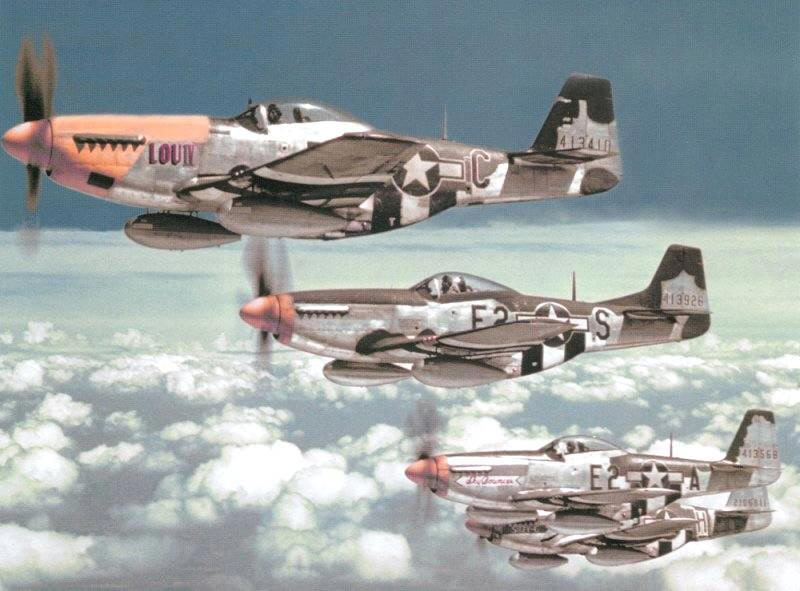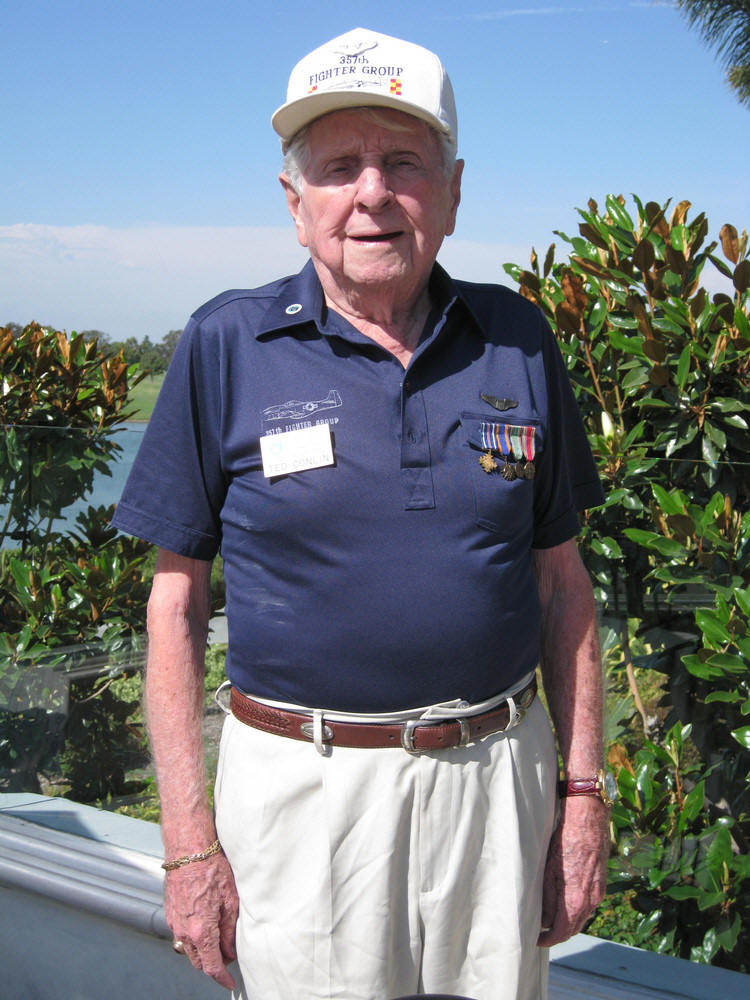Ted Conlin Flew P-51's Against The German's In WWII
See his detsailed site... Ted Conlin's exploits!



Read about Bud Andersen and his P-51 adventures.



Many top E.T.O. aces flew the P-51 Mustang. These included Captain Don Gentile (35 victories), Captain John Godfrey (31 victories), Colonel Eagleston (23 victories), Major James Howard (the only American ace in both theaters of the war--6 victories in China flying P-40's and 6 victories in Europe flying P-51's), Chuck Yeager (who later became the first man to break the sound barrier) and Colonel Donald Blakeslee (15 victories and C.O. of the famous 4th Fighter Group). The 4th FG destroyed over 1,000 German aircraft, more than any other American fighter group in WW II.
The Mustang story began in 1940 when the British contacted North American Aviation with a request to build fighters for the RAF. North American was willing, and they offered to design and build a new fighter that would meet British requirements, and be easy to mass produce. In only 100 days NAA rolled out the first prototype Mustang. By November 1941 the first of over 600 aircraft produced under British contract were delivered to the RAF.
The new fighter incorporated some advanced ideas, in particular a laminar flow wing of thin cross section, which allowed the Mustang to avoid most of the "compressibility" dive problems that plagued many other high performance fighters of the time. Two of the first ten Mustangs built were taken to Wright Field, at Dayton Ohio, for testing by the AAF, which designated them XP-51.
The 1,150 hp. Allison F-series V-12 powered the early Mustang models. This resulted in poor high altitude performance, so the RAF used their Mustang I (P-51) and II (P-51A) models for low altitude ground attack and reconnaissance duties.
The Mustang I had a top speed of 370 m.p.h. at 15,000 ft. Best climb at 11,300 ft. was 1,980 ft./min. An assortment of .30 and .50 caliber machine guns were carried, but the Mustang IA was armed with 4-20mm cannon. Handling and maneuverability were good. Like the FW 190, the P-51 was a pilot's airplane.
P-51A (Mustang II) production was divided between America and Britain. This model standardized armament as 4-.50 cal MG. (two per wing). There were ground attack versions of the P 51A in U.S. service, designated A-36A, which served the AAF in the North African campaign. There were also specialized photo reconnaissance versions of all major Mustang models, the F-6 series.
The decision was made to mass produce the outstanding Merlin engine under license in the United States. The P-51B and C models (Mustang III's in Britian), which entered service in December of 1943, were powered by the new Packard-built version of the Merlin V-12, driving a four bladed propeller. At the same time, the airframe was strengthened, the radiator was re-designed, the ailerons were improved, and racks for long range drop tanks or bombs were added under the wings.
The 1,450 hp. Packard/Merlin engine (1,595 hp. war emergency rating) gave the P-51B-7 a top speed of 445 m.p.h. Best climb was 3,320 ft./min. at 10,000 ft. The new Mustang carried 4-.50 caliber MG (two per wing), and up to 1,000 lbs. of external stores. Its range was an astounding 2,200 miles with two 150 gal. drop tanks. Endurance with drop tanks was 8.7 hours.
The new engine completely changed the character of the Mustang, turning it into a high altitude fighter suitable for bomber escort missions. It came at a crucial moment for the AAF daylight bombing campaign. Luftwaffe fighters were taking such a toll of un-escorted heavy bombers that the losses were becoming unsupportable. The great range of the P-51B-7 allowed it to escort the heavy bombers all the way to their targets deep inside Germany. In March of 1944, Mustangs went to Berlin. Eighth Air Force bomber losses plummeted, while Luftwaffe fighter losses skyrocketed.

Later in 1944 the famous P-51D model arrived. It sported a "tear drop" canopy for better all around vision and a more powerful 1,790 hp. version of the Packard/Merlin engine, along with many detail improvements. The armament was increased to 6-.50 caliber wing MG and all manner of external stores could be carried. Recognition of the D model is easy because of its teardrop canopy and the large fillet fin added in front of the vertical stabilizer. For the Luftwaffe, the end was at hand.
The final major production version of the Mustang was the P-51H. This re-designed model incorporated major improvements, as extensive in scope as those incorporated into the FW 190D or Spitfire Mk. 22.
In the H model, the structure was increased in strength by 10%, to allow higher "g" loads in combat maneuvers. No structural part was left in common with earlier models. Streamlining was improved to increase speed, and stability was increased. A new version of the Packard/Merlin, incorporating water injection, delivered over 2000 hp. These changes resulted in the finest American fighter of the war. Speed was 486 m.p.h. at 30,000 ft. best climb rate was 5,350 ft./min. at 5,000 ft. Service ceiling was 41,600 ft.
Unlike most other American piston engine fighters, which were withdrawn from service soon after the end of WW II, the Mustang fought on, doing valuable ground support work in the Korean War. It was adopted by many other nations, too numerous to list here, and remained in service in some countries into the 1960's.